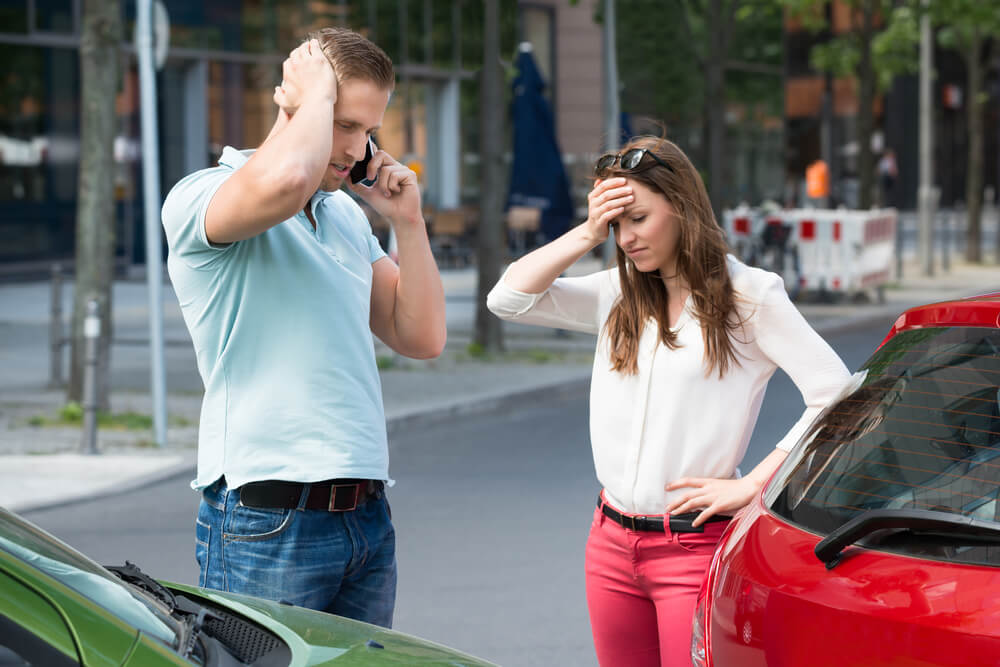Getting into a car accident is a fear of many Australian drivers. While there is no such thing as a “worry-free accident”, taking the right precautionary measures could potentially limit the financial impact a car accident may have.
Be prepared for an incident: download our brochure explaining what to do in an accident and keep it in your glove box.
Being the victim of a car accident can be stressful, and it can be hard to deal with the shock of what’s happened. With that said, it’s still vital to know the right steps to take after the accident. Here’s what to do after a car accident that wasn’t your fault:
Make sure every participant in the accident is safe and check all involved cars to see the extent of the damage.
One of the parties involved should call the police and provide accurate details of the accident, including time and date, location, contact details of all parties, and the extent of your injuries (if you are injured). Depending on the severity of the accident, it might be necessary to call a tow truck to move the damaged motor vehicle. If your car requires towing, please call your insurer for advice on who to contact. Officers from the local police station might also need to help direct traffic at the scene of the accident.
Hopefully, the driver at fault has stopped at the scene. In this case, try to gather as much information as you can, including their name, phone number, car registration number, insurance information (provider, insurance number, policy details) and drivers licence number. In return, you should give them your details to assist them with their car insurance claim.
If the driver at fault didn’t stop, things get a little tricky. You should file a police report and ask witnesses what details they remember, so you can hopefully identify the driver. They’re responsible for the damages and should be able to make a claim through insurance. If they don’t have car insurance, then you might need to look into legal avenues available to you.
Make sure you choose your words carefully when you’re interacting with the other driver. Saying something as simple as “sorry” could possibly be used against you in an insurance claim, as it may imply an acknowledgement of being at fault. Likewise, don’t say things like, “I didn’t see you,” as that can also be deemed an admission of guilt.
Instead, try and say ask questions such as:
In cases where fault may be disputed or the other driver has not stopped, accounts from witnesses on the scene could help your claim. They can help determine who was at fault during the accident, which could have a great bearing on how your insurance provider will treat your claim.
Photographic evidence of damages could be very useful. Along with witness accounts, pictures can help you in the case where fault is disputed, and may prove the extent of damage for insurance quotes. Likewise, ask if witnesses have photos, video or dashcam footage of the incident that they can share with you.
To ensure your claim goes through as quickly as possible, it’s recommended that you call your insurance provider at the earliest opportunity.
![]() Emergency: 000
Emergency: 000
Police attendance: 131 444

If you have caused an accident, it’s important that you do everything you can to assist the other parties involved – whether it’s the other driver, the police, or the insurance providers. Generally, if you’re wondering what to do after a car accident where you’re the responsible party, these are the usual steps:
Ensure the wellbeing of both yourself and other person involved in the accident. Make sure you also check both cars, to get an idea of how much damage has been done, and put on your hazard lights if necessary.
This is important for both your insurance claim and if you are potentially summoned to court. The more accurate the information you can give about your accident, the more your insurance provider will be able to help you.
Get as much information about the other person involved as possible. If they didn’t stick around, check with witnesses to see if they can provide statements, photos or video of the event to make the claim process as smooth as possible. When talking to the driver, ask for:
As a common courtesy, you should exchange details and help them with information related to their car and property damage insurance claim.
No matter the scale of the accident, you should generally contact the police. They can document your accident from an unbiased perspective, which could help your claim.
After collecting all the required information, you may wish to make a claim with your insurance provider as soon as possible.
It’s important to note that if it has been determined that you have been responsible for causing a car accident, your insurance premium may increase once your policy is up for renewal. You will also have to pay an excess payment if you are at fault.
Please note: your car insurance policy must have been in force before the accident to make a claim.
Since it’s illegal to drive a car without Compulsory Third Party (CTP) insurance, there are some costly penalties for uninsured drivers who get into accidents. Some of the consequences include fines, suspension of both your licence and car registration, and in the worst-case scenario, jail time.
On top of all those potential scenarios, you may also be responsible for paying for the costs of the other person’s car and medical bills if you are found to be at fault. In any case, driving without insurance isn’t recommended.
At a minimum, every driver should have CTP (sometimes known as Green slip insurance) – a policy that protects you by covering the expenses of the other participants involved in case of injury or death. As the name suggests, CTP is the one insurance policy that is mandatory for all registered drivers (other policies like Third Party Property Damage and Comprehensive car insurance are optional).
If you don’t know what to do in a car accident that’s left your car in a dangerous position, the following steps could help you:
Ensure that your car’s engine isn’t running, as this could be an additional hazard.
Your car is important, but the safety of other drivers and passengers should be the priority. If anyone requires emergency services after a car crash, call emergency services on 000.
While waiting for the ambulance, you can perform first aid on injured passengers if it’s safe to do so. However, don’t attempt to move the injured passenger if you believe they may have spinal or head injuries. Wait for medical professionals to arrive.
One way you can make sure no one else is impacted by the accident is by clearing the crash site of any hazards if it is safe to do so and both parties have taken photos of the accident. This may include moving any stray items that have fallen off your vehicle like pieces of the bodywork or luggage.
However, do not do anything that puts you at risk of injury. Be careful when moving pieces of car debris as it can have sharp edges. Do not pick up pieces of broken windshield with your fingers. Emergency responders can clear dangerous objects, including broken glass and fuel spills.
For police attendance, call 131 444. If you believe someone in the accident needs emergency services, call 000.
While these steps can help you if you’re unsure what to do after a car accident, it’s important to note that you should only do what you believe you’re physically capable to do. If you are injured or believe one of the listed steps may be too dangerous, wait until you can get some assistance. If your car requires towing, please call your insurer for advice on who to contact.
Are you registered for roadside assistance? With our roadside assistance comparison service, you can find a policy that can help you if your car breaks down.

As General Manager of General Insurance at Compare the Market, Stephen Zeller is passionate about demystifying car insurance for consumers, so they have a better understanding of what they’re covered for. There are different types of car cover: comprehensive, third party fire and theft (TPFT) and third-party property damage (TPPD).
Stephen has more than 30 years of experience in the financial services industry, and is an Allied Member of the Australian and New Zealand Institute of Insurance and Finance (ANZIIF) and helps review general insurance content on Compare the Market to ensure it accurately breaks down complex insurance topics.
Car accidents can be stressful for all parties, and if you don’t have the right car insurance policy, expenses could come directly out of your pocket. However, a comprehensive car policy can help cover your repair costs after a car accident – even if you were at fault.
Don’t let car accident bills cause an after-shock.
With Compare the Market’s free car insurance comparison service, you can compare the rates and features of various car insurance providers in just minutes and find a great-value policy.
Don’t stall now. See if you can track down better car insurance cover
Compare car insurance